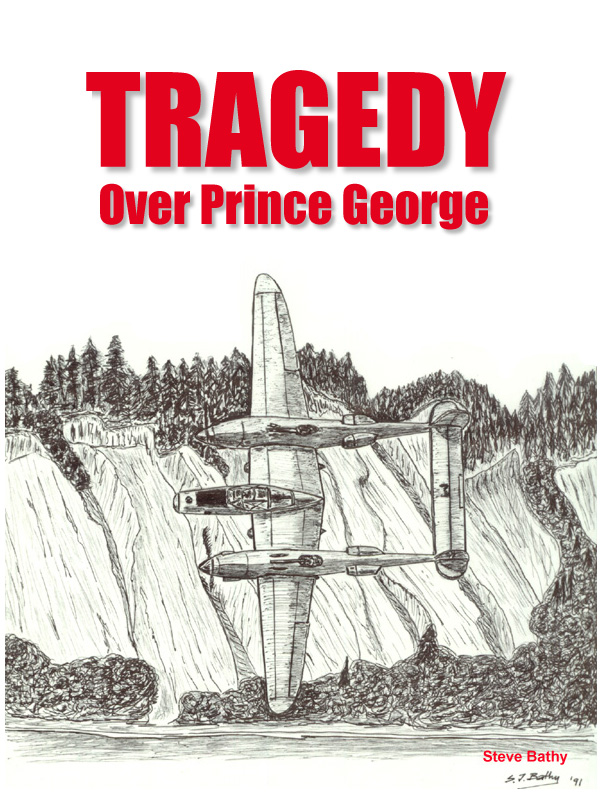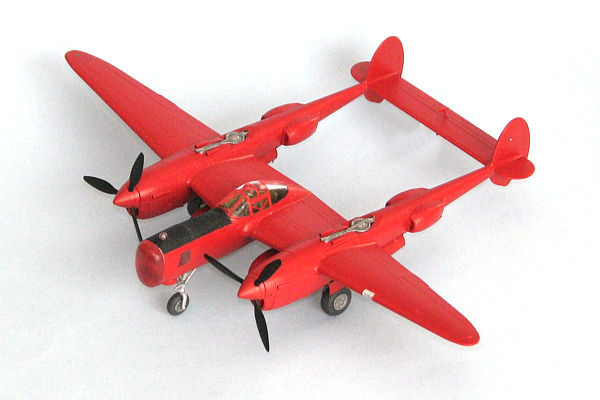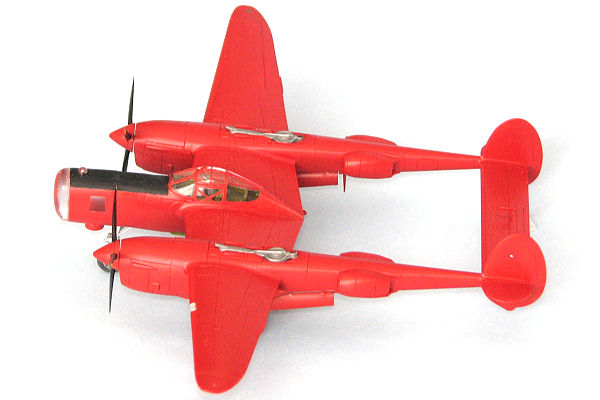

Less than a mile from the busy downtown of Prince George, B.C., lies a deep ravine. The area is shrouded in silence where stillness is broken only by chattering squirrels or chirping birds.
Windfalls, uprooted trees, underbrush, foliage and years of fallen leaves almost completely hide what remains of a P-38 Lightning aircraft, while devil's club and thistle protect the site
from all sides. The wreckage: portions of wings, fuel tanks, propellers and engines, is scattered over the area.
Those engines roared to life for the last time on June 25, 1956.
Frank Pynn, a 32 year old former Royal Air Force Bomber Command pilot left the lounge of a local hotel around 5 o'clock in the afternoon. He and his navigator/photographer, Bruce Hill, 30,
had spent a few hours there enjoying a few beers.
Pynn was a competent flyer with absolutely no lack of confidence. He was licensed to fly in England, Canada and the USA. During his flying career, he accumulated around 4,000 flying hours,
in excess of 20 them on the P-38. After the Second World War, he became a Canadian citizen but made his home in California after taking up air survey work.
Pynn was equally at home at high altitude or at the low level precision flying that was required to drag a magnetometer over mineral-rich northern Canada.
He and the crew arrived to Prince George on June 13 from Los Angeles.
The P-38 was chartered by the Federal Government from Vancouver Aero Surveys Ltd., a subsidiary of Fairchild Aircraft of California, to photograph some 600,000 square miles of northern
Canada from Edmonton to the Queen Charlotte Islands. The job was expected to take two months. It was a job, in Pynn's words, "of extreme monotony punctuated by moment of sheer terror."
On that Monday afternoon, Pynn started to head for the airport to pick up the mail for the crew. He never got the mail. No one knows why, somewhere between the town and the airport, he
decided to take the Lightning out of the hangar and fly it. Perhaps to check the plane's radio equipment that had been defective a few days earlier and had been repaired by Allan Clarke,
radio operator for the Department of Transport in Prince George. Pynn checked with Clarke when he arrived at the airport. Clarke had detected the smell of alcohol on Pynn's breath but
believed he was sober because the way Pynn could discuss with him the intricacies of his radio indicated to Clarke that Pynn was "in full possession of his senses." Pynn, with his impending
flight in mind, casually asked if anybody wanted to accompany him.
Clarke's 15 year old son, Jimmy, who had just arrived back from a Vancouver boarding school on the bus couple of hours earlier grabbed the opportunity. He loved aeroplanes and this was his
big chance to fly for the first time, on top of it, in one of World War II's hottest aircraft.
The P-38 had been readied for the next day's mission and it was fully loaded with fuel, including the auxiliary tanks. Pynn and the youngster climbed into the plane (Jimmy sat behind the
pilot in the piggy-back seat) and taxied out for take-off. The pilot's radio transmission reached Clarke loud and clear. Clarke gave the take-off clearance. He noticed that the pilot seemed
to take an unusually long time over his cockpit check, but finally released the brakes and made a normal take-off. The Lightning returned over the airport a few minutes later in a "screaming
dive" and "shot up" the airport.
According to an eyewitness, Pynn approached the administration building at a height of "not more than 15 or 20 feet" above the ground level and cleared the control tower "by only a few
feet". Then he turned toward the town. Hundreds of city residents saw the Lightning roar over the houses at low level. Low it was indeed! Ball players on a field (now the site of the Civic
Centre) "hit the deck from fright" as the P-38 zoomed dangerously low overhead and then clipped a tree in the Winnipeg Street area.
The screaming sweep over the city at a height of only about 150 feet alarmed a large segment of the population. The airport office of Canadian Pacific Airlines received a telephone call
about the antics of the plane but the report ironically and tragically was never relayed to the only person who could contact the plane and ask Pynn to return to the airport or at least
confine his flying to higher altitude, Mr. Clarke. But Clarke was not aware of the situation and the only people who could have told him did not think it was necessary! Meanwhile, the
Lightning was heading east toward Six Mile (now Tabor) Lake made a sweep over it then swung back toward the city crossing the Fraser River near the PGE (now BC Rail) bridge. It just missed
the top of the Prince George Hotel as it headed toward the cutbanks of the Nechako River.
Eyewitnesses' accounts differ on what happened next. The Lightning roaring toward the cutbanks went into a half roll, seemed to fall over on its back and nosed toward the ground. Before the
plane hit the trees, the throb of the engines mounted to a brief roar indicating that the pilot was trying to get the nose up by applying more power. But it was too late. "A tongue of white
flame leaped 200 feet into the air, there was a muffled explosion, like thunder, and black smoke wound up of the trees."
The tragedy happened approximately two minutes after 7 o'clock. Police and BC Forest Service personnel found the smoldering remains of the aircraft in a deep ravine. The scene was one of
appalling destruction. Hardly a single component of the plane was readily recognizable. The largest piece was little more than six feet in length. Charred remains of the parachute were
hanging grotesquely from the branch of a tree. Reconstruction of the few seconds leading up to the crash from salvaged portions of the aircraft was impossible. "Evidence at the scene of the
crash showed that the plane dove almost straight into the ground shearing the tops of only a handful of small saplings in its descent."
The subsequent inquest found that Pynn died "through his own neglect and complete disregard for the Aeronautical Regulations of Canada."
Today, in the Prince George cemetery two graves are the silent reminders of a spectacular but tragic "air show" that took place five and a half decades ago.

The Lockheed P-38 Lightning was famous for its wartime exploits in the Pacific but in peacetime it found ready work as a high altitude camera platform. CF-HSC was built in 1943 as a P-38L-5-LO then converted into an F-5G-6-LO, a photo-reconnaissance variant. After the war she had a career as an air racer before being converted into a survey machine. (Steve Bathy)

Steve built his first plastic model in 1958, and hasn't stopped since. His collection includes nearly 900 model airplanes, automobiles, tanks, trains and figures. (Steve Bathy)
References:
World War II Combatants: The Prince George Connection, Stephen Bathy
The Citizen, Prince George, B.C., June 18, 1956
The Citizen, Prince George, B.C., June 28, 1956
The Citizen, Prince George, B.C., November 23, 1981
Government of Canada, AARCE, Ottawa, Ont., File No. 5008-Z